I think I may have mentioned that I am fond of vintage Parker pens. My admiration dates back to the late 1960’s when I collected Parker advertisements from newspapers and magazines. A Parker was also my first “grown-up” fountain pen when I went to my secondary school. It follows that this blog post might come across as slightly biased.
The Parker 45 model was part of the current range when I was at school. Buying a new one in town was a rare treat. I remember using them in lessons to write in exercise books. If you left one uncapped for too long the nib was likely to dry out, although this is true of most fountain pens.
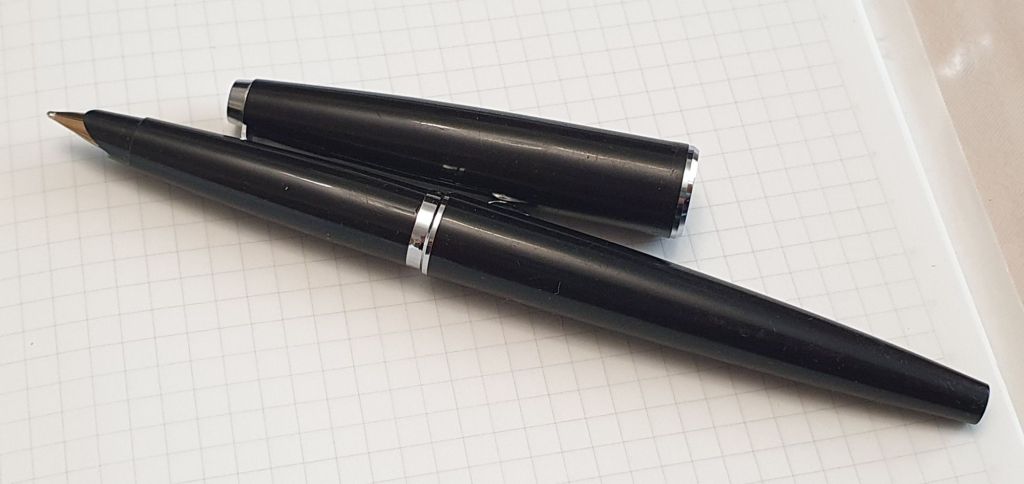
In those days, I would have used the cheaper, steel nib versions, mostly Medium. They were also available with gold nibs. I do not recall being aware that there was such a wide choice of gold nibs to choose from for the Parker 45. The nib grade is shown by a letter on the underside of the little black nib housing. I never ventured beyond M (medium) and F (Fine). Only recently, have I discovered the X (Extra Fine) and the R (Medium Oblique). For a list of the nib codes, see the following thread on Fountain Pen Network.
I still have a couple of my Parker 45’s from the seventies – one in grey and another in brushed stainless steel. As ever I recommend Tony Fischier’s site, Parkerpens.net for an authoritative and comprehensive history of the Parker 45 range. They were produced from 1960 until 2007 and heralded the beginning of the Parker Quink cartridge system. The all-plastic version was called the Parker 45 Arrow. The version with a metal cap was the Parker 45 Classic and the brushed stainless steel version (very desirable to my 11 year-old self) was the Parker 45 Flighter.
Fast-forwarding to the present, my fountain pen journey took me down the vintage Parker rabbit hole. Last year was my year of the Parker-buying. I swooped on the inexpensive but surprisingly good Parker 17 models at pen shows and on eBay, before moving on to the Parker 61 and 51.
In the midst of this run, I happened to spot a Parker 45 Classic with a somewhat rare Medium Oblique (code “R”) nib, which proved to be delightful. Oblique nibs seem to be the most flattering for my handwriting when using a lefty-overwriter style, whereas non-oblique nibs work better for me in an underwriter style.
My last Parker pen purchase of 2023 was bought on eBay and intended as a Christmas present for someone else. It was a black model with a 14k gold Medium nib. But here’s the strange thing: after testing it the writing experience was so utterly delicious, exquisite and wonderful, that I honestly could not bring myself to part with it and had to keep this one for myself. Selfish, shameful and shocking I know, but true.
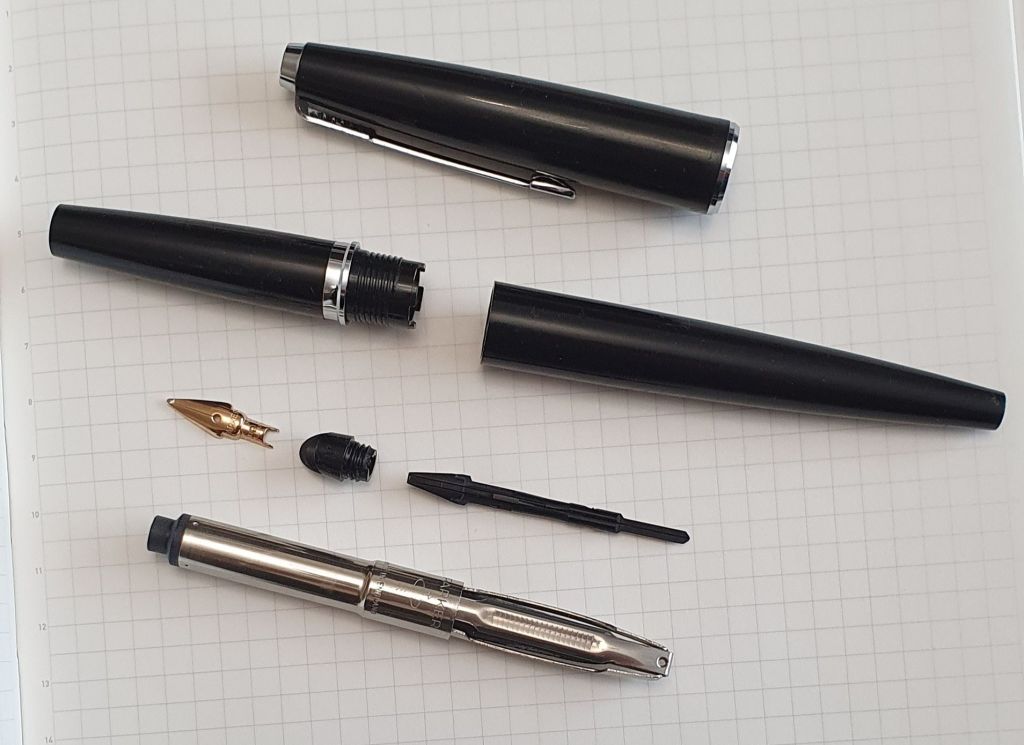
But then, like a drug (I imagine), or at least chocolate, I craved another one. Happily at the London Spring Pen Show in March, I spotted and pounced on a lovely midnight blue model with a Fine nib. And then finally, back more recently on eBay I bought a burgundy red model with the less-common Extra Fine nib.
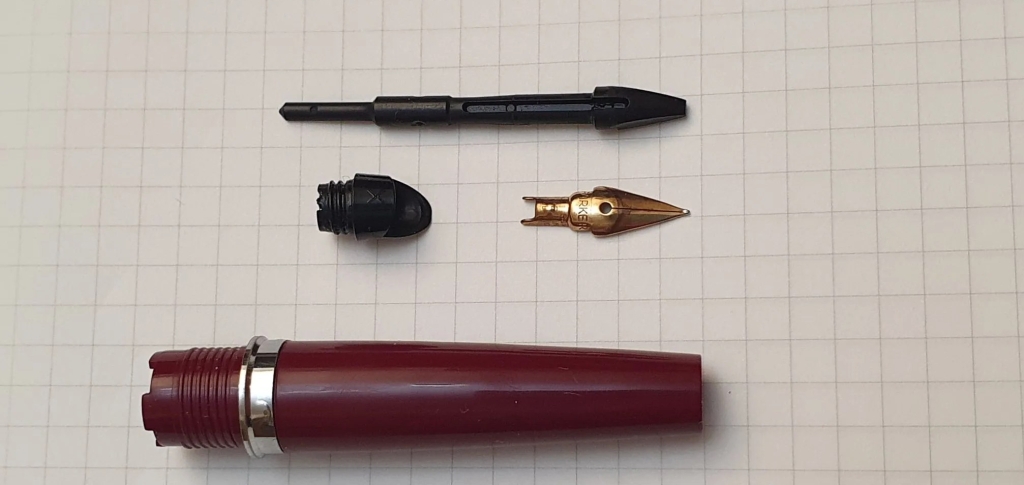
And so in the last seven months, my little Parker 45 family grew from two to six pens. My four recent buys all having 14 gold nibs, have all been superb and yet each cost between around £20 to £25 only.
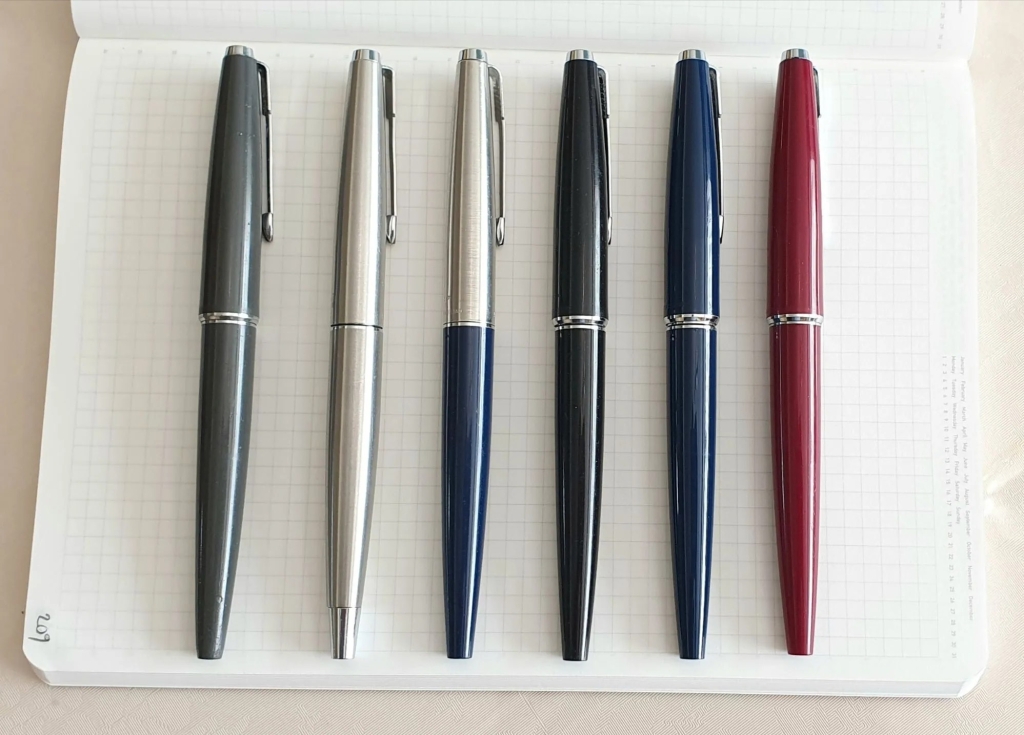
“What is so good about them?” you might ask. Here are a few answers:
- Comfortable to hold (not too short, long, heavy or light; not having any step or cap threads);
- Well balanced whether used unposted or posted. The lightweight cap posts very deeply and does not throw the balance off;
- Convenience of accepting cartridges or a converter;
- Great-looking pen (subjective and in the eye of the beholder, I know);
- Best of all, having a screw-in nib housing. The nib, feed and housing can be removed easily for cleaning or nib adjustment; this is where the 45 scores over the 17, 51 or 61.
- Can be found at pen shows or on eBay for a very modest outlay – similar to the cost of a Lamy Safari or Cross Bailey Light, both of which would have steel nibs.
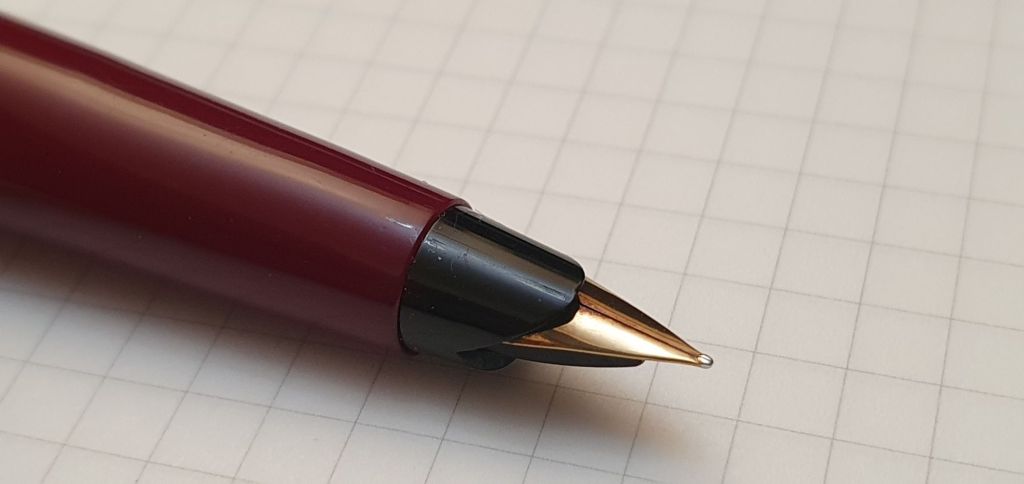
In summary, it comes down to good design. I read on Tony Fischier’s site (linked earlier) that the Parker 45 was designed by Don Doman who also designed the Parker 61 and Parker 75 amongst others.
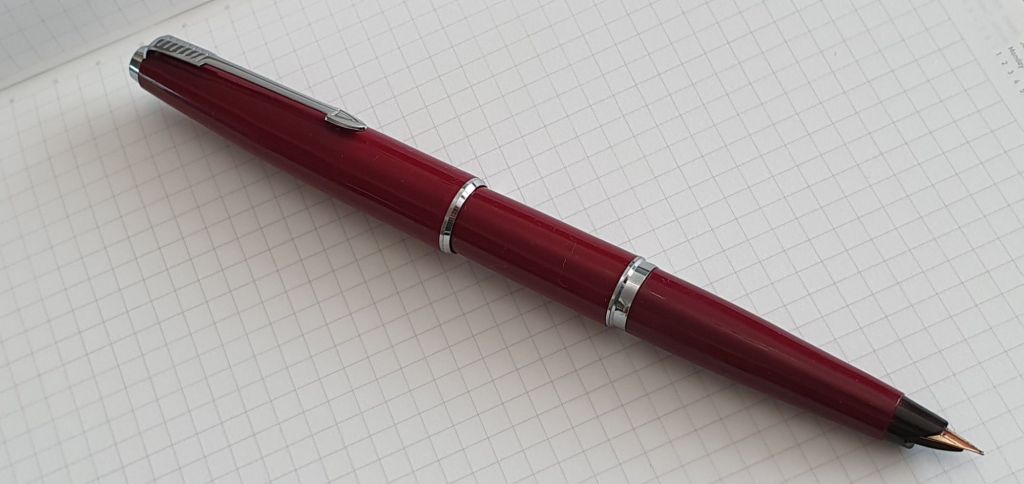
Are there are any negatives? Yes, the type of plastic material used for the Parker 45 is softer and inferior to the material of the Parker 51. It would show bite-marks, rather like a chewed cap of a Bic Crystal biro.
Size and Weight: The length capped is around 136mm or uncapped, 127mm. The length posted is 145mm. The all-plastic version weighs around 17 grams, or 12 grams uncapped, whilst the Flighter is only slightly heavier at around 20 grams.
For anyone who has any liking for fountain pens, let alone an obsession, vintage Parkers can save you money, so long as you do not buy too many of them. Which is why (as politicians annoyingly say), I have garnered a reputation in my pen club as the vintage Parker influencer.
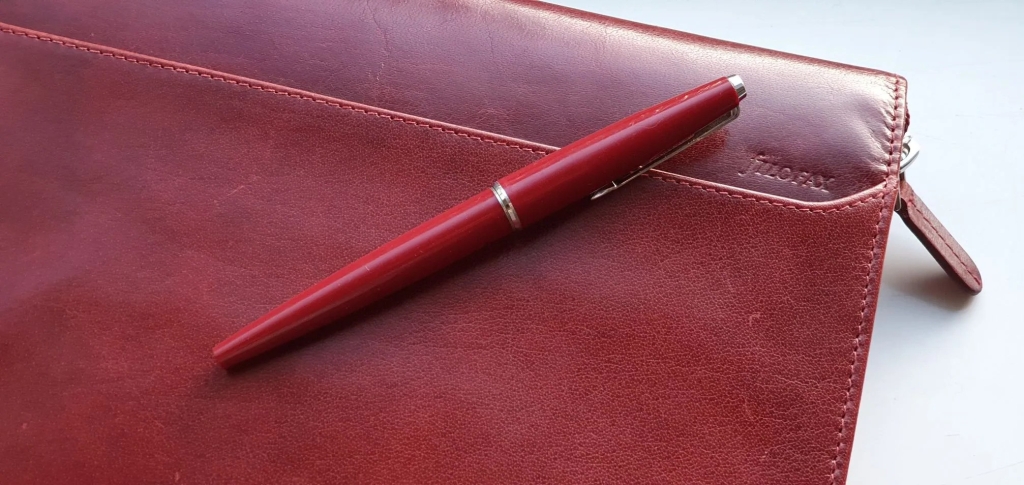

I love Parker fountain pens, and the 45 are excellent for my small hand and round, slow writing style.
LikeLiked by 1 person
Thanks Raffaello. To my mind, the 45 was such a successful design that still looks good and performs well today, it is surprising that it was discontinued, although it had a long innings.
LikeLiked by 1 person
I still write with my 2 45s, inked with different inks. Yet, quite frequently I also carry a Jotter fountain pen, very well balanced, inexpensive, but with a creamy nib that I actually love.
You are right, it’s a shame they stopped the production of such a brilliant pen.
LikeLiked by 1 person
Thank you so much for sharing. A delightful trip down memory lane. I too have fond memories of using both Platignum and Parker 45’s at school in the UK. The Platignums were rubbish. Cheap plastic, scratchy nibs. They always hard started and often burped ink. On the other hand the 45s were a dream, good quality and smooth writers but I always ran out of ink. So like many others at the time ballpoints quickly replaced fountain pens. Parker Jotters were my preferred weapon of choice but too often were nicked. Instead I saw through my exams with a miserable selection of cheap ballpoints and chewed end cristal BICS. Functional is the only adjective that comes to mind. Sigh! Thirty five years later, 2018 I was intrigued by a Youtube video on the Lamy Safari by Goulet Pens. Using the Lamy Safari was a joy and I very quickly fell down the rabbit hole collecting special edition Parker IMs and Jotters.
Finding vintage Parker Pens on eBay led to a dive into 45s,51s,61s,65s,75s,180s & NS Duofolds. Every single one are a joy to use and just show how innovative Parker was.
Although current passion is for vintage Aurora Pens from the 60s and 70s Parker will forever always be my first love.
LikeLiked by 1 person
Thanks Paul. It sounds like you and I are of a similar vintage. I remember Platignum pens at school, and also Osmiroid. I had one which was a lever filler and recall that, when sitting a school entrance exam, one of the other boys fiddled with the lever just before the start, emptying the pen into its cap. But I often went home with ink on my fingers and shirt. (No change there then).
Moving on to Parker pens later was a definite upgrade.
You seem to have fallen deep down the vintage Parker rabbit hole, as well as collecting their more recent models. I am glad to hear that you have had success with them.
I have a few different modern Aurora pens (an Ipsilon, Duo-cart, Talentum, Optima and my favourite, the 88) but no vintage Auroras – at least, not yet.
LikeLike
What a good-looking set of pens. I’m very partial to that brushed steel one – the Flighter. And the red.
LikeLiked by 1 person
Thanks Pamela. Yes, they are a handsome bunch and the design still looks good today. The Flighter was a dream pen to me as a child, whilst my school friends were more interested in football. My first Parker pen, a green Duofold disappeared within my first few weeks at secondary school. If I remember rightly, my parents then sent me Parker 45 Flighter to replace it, this time with my name engraved on it, but this did not stop it disappearing too. The one in the photograph came some time later and is not engraved.
LikeLike
I have a 1961 Parker 45 with gold nib.
LikeLiked by 1 person
I enjoyed your review. The Parker 45 was my first fountain pen, and I now have it in virtually every version, including but not limited to the Classic in hard-to-finds magenta (recently obtained after a 2-year search) and yellow (3 of them now), and the Harlequins in every version (most recently obtained the black circlet). I have probably every P45 nib width, but most enjoy the medium and broad for normal writing. It is in so many ways covered by you a great-writing pen and so very easy to clean. — Donn Weinberg
LikeLiked by 1 person
Thank you! It sounds like you have a very comprehensive collection of this range of pens. Although I enjoy using many other Parker vintage pens, it is arguable that the Parker 45 was the best all-rounder by virtue of its comfortable ergonomics, enjoyable and reliable nibs, ease of maintenance, versatility in filling options and not least, its low cost.
LikeLike